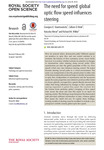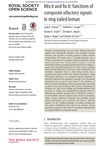Education: Recent submissions
Now showing items 421-440 of 806
-
Artificial light onwater attracts turtle hatchlings during their near shore transit
(2016)We examined the effect of artificial light on the near shore trajectories of turtle hatchlings dispersing from natal beaches. Green turtle (Chelonia mydas) hatchlings were tagged with miniature acoustic transmitters and ... -
Responsiveness to conspecific distress calls is influenced by day roost proximity in bats
(2016)Distress calls signal extreme physical distress, e.g. being caught by a predator. In many bat species, distress calls attract conspecifics. Because bats often occupy perennial day-roosts, they might adapt their responsiveness ... -
Estimation of self motion duration and distance in rodents
(2016)Spatial orientation and navigation rely on information about landmarks and self-motion cues gained from multi-sensory sources. In this study, we focused on self-motion and examined the capability of rodents to extract and ... -
Difluoromethanesulfonyl hypervalent iodoniumylides for electrophilic difluoromethylthiolation reactions under copper catalysis
(2016)Difluoromethanesulfonyl hypervalent iodonium ylides 2 were developed as electrophilic difluoromethylthiolation reagents for a wide range of nucleophiles. Enamines, indoles, β-keto esters, silyl enol ethers and pyrroles ... -
Ravens New Caledonian crows and jackdaws parallel great apes inmotor self-regulation despite smaller brains
(2016)Overriding motor impulses instigated by salient perceptual stimuli represent a fundamental inhibitory skill. Such motor self-regulation facilitates more rational behaviour, as it brings economy into the bodily interaction ... -
Open research practices
(2016)The Peer Reviewers’ Openness Initiative (PROI) is a move to enlist reviewers in the promotion of data-sharing. In this commentary, I discuss objections that can be raised, first to the specific proposals in the PROI, and ... -
The need for speed
(2016)How do animals follow demarcated paths? Different species are sensitive to optic flow and one control solution is to maintain the balance of flow symmetry across visual fields however, it is unclear whether animals are ... -
Balancing macronutrient intake in amammalian carnivore
(2016)There is a large body of research demonstrating that macronutrient balancing is a primary driver of foraging in herbivores and omnivores, and more recently, it has been shown to occur in carnivores. However, the extent to ... -
Do grandparents compete with or support their grandchildren?
(2016)Previous research has found that the presence of grandparents, particularly grandmothers, is often positively associated with child survival. Little research has explored the potential mechanisms driving these associations. ... -
Parents face quantity quality trade offs between reproduction and investment in offspring in Iceland
(2016)How to optimally allocate time, energy and investment in an effort to maximize one’s reproductive success is a fundamental problem faced by all organisms. This effort is complicated when the production of each additional ... -
Physiological tremor reveals how thixotropy adapts skeletal muscle for posture and movement
(2016)People and animals can move freely, but they must also be able to stay still. How do skeletal muscles economically produce both movement and posture? Humans are well known to have motor units with relatively homogeneous ... -
Mix it and fix it
(2016)Animals communicating via scent often deposit composite signals that incorporate odorants from multiple sources however, the function of mixing chemical signals remains understudied. We tested both a ‘multiple-messages’ ... -
Socially segregated sympatric spermwhale clans in the Atlantic Ocean
(2016)Sperm whales (Physeter macrocephalus) are unusual in that there is good evidence for sympatric populations with distinct culturally determined behaviour, including potential acoustic markers of the population division. In ... -
Multiple stage decisions in amarine central place forager
(2016)Air-breathing marine animals face a complex set of physical challenges associated with diving that affect the decisions of how to optimize feeding. Baleen whales (Mysticeti) have evolved bulk-filter feeding mechanisms to ... -
Conflict between background matching and social signalling in a colour-changing freshwater fish
(2016)The ability to change coloration allows animals to modify their patterning to suit a specific function. Many freshwater fishes, for example, can appear cryptic by altering the dispersion of melanin pigment in the skin to ... -
Deceived by stripes
(2016)Conspicuous coloration, which presumably makes prey more visible to predators, has intrigued researchers for long. Contrastingly coloured, conspicuous striped patterns are common among lizards and other animals, but their ... -
Brain serotonergic activation in growth-stunted farmed salmon
(2016)Signalling systems activated under stress are highly conserved, suggesting adaptive effects of their function. Pathologies arising from continued activation of such systems may represent a mismatch between evolutionary ... -
Coevolutionary interactions between farmers andmafia induce host acceptance of avian brood parasites
(2016)Brood parasites exploit their host in order to increase their own fitness. Typically, this results in an arms race between parasite trickery and host defence. Thus, it is puzzling to observe hosts that accept parasitism ... -
Multiple behavioural morphological and cognitive developmental changes arise froma single alteration
(2016)Subtle variations in early rearing environment influence morphological, cognitive and behavioural processes that together impact on adult fitness. We manipulated habitat complexity experienced by young pheasants (Phasianus ... -
Gone with the heat
(2016)Images of dust continuum and carbon monoxide (CO) line emission are powerful tools for deducing structural characteristics of galaxies, such as disc sizes, H2 gas velocity fields and enclosed H2 and dynamical masses. We ...




















